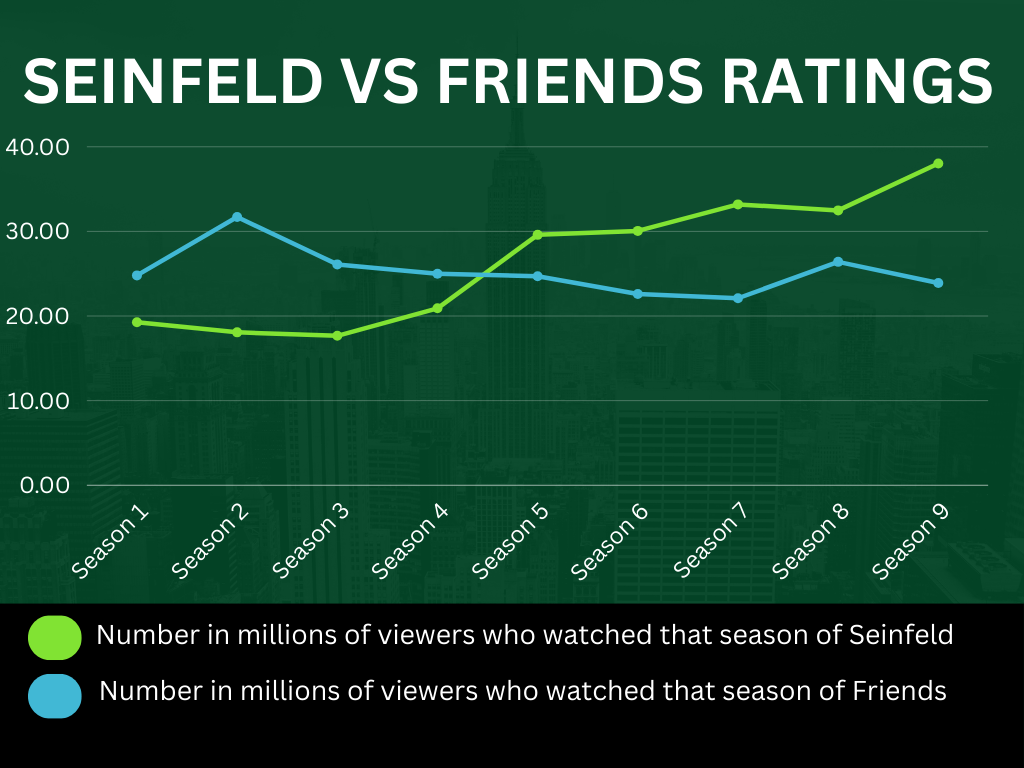WhatтАЩs the deal with the тАЬSeinfeldтАЭ finale?┬а
Long-running HBO sitcom тАЬCurb Your EnthusiasmтАЭ recently ended on April 7th, 2024. The finale episode, тАЬNo Lessons Learned,тАЭ was released to great acclaim, and not just for its dry wit and charm. The finale received a lot of attention for serving as a homage and reference to the controversial finale episode of creator and star Larry Davids first show, тАЬSeinfeld.тАЭ
тАЬSeinfeldтАЭ had already been recirculating in the news back in October after stand-up comedian, actor and co-creator Jerry Seinfeld hinted at a possible future project finale. The comedian said at a comedy show that both he and co-creator and head writer David were in talks about doing тАЬsomethingтАЭ. What that something entails was left vague, but a reunion was implied. However, it isnтАЩt clear how serious Seinfeld is, since actors Jason Alexander and Julia Louis-Dreyfus both seem to be left in the dark about this project, and Michael Richards has not mentioned it.┬а
Seinfeld has openly admitted that he regrets the drama of the finale, and believes that тАЬbig is always bad in comedy.тАЭ The finale is, to many, not that funny, but does that devalue it completely?
тАЬSeinfeldтАЭ famously ended on a high note. It left a legacy as the fourth most-viewed TV show finale in history, which put it ahead of competition like тАЬFriendsтАЭ and the тАЬCosby Show.тАЭ It was incredibly lucrative as well; by the final ninth season Jerry Seinfeld was making $1 million an episode while co-stars Louis-Dreyfus, Alexander and Richards each brought home around $600,000.
While the network it ran on, NBC, never wanted the show to end, Seinfeld didnтАЩt agree. David left the show at the end of the seventh season because he feared the quality would decline. While they were equipped with a number of talented writers, the loss of David was a massive hit. The show still remained funny, and the ratings stayed on top, but the show ended just two seasons later. According to Alexander, it was a result of burnout and a feeling amongst the writers that there was nothing new that could be done with the characters.

тАЬ[The first time I saw the finale], I cried for no less than an hour. I liked how it moves back around [and touches on earlier plotlines]. At the same time, seeing something so beautiful would make any respectable person just fall to their knees in tears,тАЭ said senior Tommy Eschbach.
тАЬSeinfeldтАЭ is one of just a few shows to end on a high note. Far too often we see shows тАФ┬а particularly sitcoms тАФ grow uninspired and exhaust once-devoted fans. As one of AmericaтАЩs most beloved shows, the end of Seinfeld was always going to be bittersweet. However, the finale did not receive a melancholic send-off. Instead, it was met with controversy, disappointment, and even betrayal.
The finale showed Jerry and his best friend George, portrayed by Jason Alexander, finally getting the deal of a lifetime. NBC is not only going to commission their show, but they will fly the two and their friends Elaine and Kramer out to any destination they choose. The four choose Paris, but on the flight there they have to make a quick pit stop in Latham, Massachusetts after complications with the plane arise.┬а
While walking around the town, the group witnesses a man being mugged, but instead of doing anything about it, they mock the man for his weight while their friend Kramer films. They are found to have violated the townтАЩs good samaritan law and are put on trial. In a proper full-circle moment many of the past guest characters who our main four have wronged in the past come back as witnesses, testifying of the wrong they had to endure as a result of their antics.
After hearing the testimonies of all the awful things Kramer, Elaine, Jerry and George have done, the judge overseeing their case decides they should end up in jail. The last conversation held by any of the characters is Jerry criticizing Georges’s shirt buttons тАФ the same conversation that took place in the very first episode.
Though this ending is humorous, itтАЩs polarizing. Fans felt upset; they had rooted for these characters for a decade, only for them to wind up with a horrible ending.┬а
The problem with that kind of mindset lies with people’s misunderstanding of the characters. Each episode typically features the same plotline: one of the characters is stuck in an unfortunate situation, and then does something morally questionable but understandable, either as a reaction or to get out of the situation. People can see themselves in these characters; no one is perfect, and people do bad things.
тАЬJerry clearly does [belong in jail]. But George? My George? No. [To Elaine and Kramer] IтАЩm indifferent,тАЭ said Eschbach.┬а┬а
But these poor actions accumulate over the years. Regardless of how understandable the actions may be sometimes, the characters are bad people.┬а
The eponymous Jerry Seinfeld, like his namesake and actor, is also a stand-up comedian and Superman fanatic. He is often made into the straight man of the show, showing shock and sometimes disgust at the actions of his cohorts. But he equally commits such immoral actions. In the episode тАЬThe Rye,тАЭ Jerry steals a loaf of marble rye from an old woman. In another, тАЬThe Implant,тАЭ he breaks up with a woman because he suspects her breasts are fake. And in тАЬThe Merve Griffin ShowтАЭ тАФ or what would probably be the worst episode of the entire show had it not been for KramerтАЩs sub-plot тАФ Jerry drugs a woman to play with her rare toy collection.┬а┬а┬а
George is cold-blooded. In the episode тАЬThe Invitations,тАЭ his fianc├йe тАФ whom he was dreading marrying тАФ dies after he purchases cheap envelopes, and she passes away after licking them shut. Yet, George is not sad at his partner’s death, nor does he feel guilty that it was his cheapness that killed her. HeтАЩs not even indifferent. He is elated that his fianc├йe, a woman with a family and friends who love her, has died.┬а
KramerтАЩs awful actions are typically more out of cluelessness than bad intent, but he has his moments. In тАЬThe Handicap Spot,тАЭ Kramer pressures George into parking in a handicapped spot, which indirectly leads to a woman in a wheelchair injuring herself. Kramer and George then go to replace her wheelchair, but a mix of Kramer’s apathy and George’s cheap streak ends with them buying the least expensive wheelchair in the store. Consequently, the wheelchair has faulty breaks, and the episode ends with the wheelchair speeding down a hill.┬а
Even Elaine, arguably the most morally sound of the four, makes bad decisions. In the beginning, in a few episodes, we do see her having a strong moral compass. In тАЬThe Couch,тАЭ she hesitantly breaks up with a man she liked a lot because he was pro-life, and in тАЬThe SuicideтАЭ she gets herself and George kicked out of a psychic apartment because Elaine is appalled that the psychic is smoking while pregnant. Elaine’s antics rarely come close to the level of her male counterparts, but that doesnтАЩt negate her selfishness. In тАЬThe Engagement,тАЭ she hires Kramer and JerryтАЩs antagonistic Newman to kidnap a noisy dog that lives in her apartment complex. Or in тАЬThe Soup Nazi,тАЭ she puts a small restaurant out of business because he hurt her feelings after she purposely provoked him.
These characters are simply not fit for society. Judge Art Vandelay, who appears in the finale, says it best. тАЬI do not know how, or under what circumstances the four of you found each other, but your callous indifference and utter disregard for everything that is good and decent has rocked the very foundation upon which our society is built. I can think of nothing more fitting than for the four of you to spend a year removed from society so that you can contemplate the manner in which you have conducted yourselves.тАЭ┬а
It wouldтАЩve been easy for the writers to phone it in and write some unmemorable, typical finale. They couldтАЩve given the viewers exactly what they wanted: Jerry and George move to LA, they throw in the classic тАЬone last walk around the apartmentтАЭ scene, maybe finally revealing JerryтАЩs hidden fourth wall. And a kiss between Jerry and Elaine that is shoehorned in, and fans are happy.
But they didnтАЩt. They did what was not only funny but made sense for the characters. тАЬSeinfeldтАЭ has never been a sentimental show. The second any of the characters show real emotion, the others freak out. It wouldтАЩve been a disservice to the characters, to the fans and to art itself to pretend that the characters deserved any more than their stint in jail. This dedication to the integrity of the show alone is why many consider тАЬSeinfeldтАЭ to be the first sitcom to transcend from a mere show to art.
The last conversation the characters have тАФ the one about George’s shirt buttons тАФ may seem like one final trivial conversation, but itтАЩs probably the only deep one that they ever share. It reflects that throughout the series not a single character experienced any growth. They never learn a single lesson, inspiring the тАЬno hugging, no learningтАЭ mantra that the show was famous for.┬а

![Comedians Jerry Seinfeld and Larry David came up with the idea for the premise of тАЬSeinfeld,тАЭ the show about nothing, after they realized that thereтАЩs nothing funnier than two funny people just talking. тАЬ[тАШSeinfeldтАЩ is different from other sitcoms] because no other show delves as deeply into the intricacies of society in a way that Jerry Seinfeld and the crew do whenever they get into wacky adventures,тАЭ said senior and тАЬSeinfeldтАЭ enthusiast Tommy Eschbach.](https://pwestpathfinder.com/wp-content/uploads/2024/04/Add-a-heading-22.png)



![There are more than 20 open cardio machines at Crunch Fitness. I enjoyed the spacious environment at Crunch, a sentiment that was shared by sophomore Sanjana Daggubati. тАЬ[Going to] Crunch Fitness was the right decision because [it] feels more professional. CrunchтАЩs workers are laid back, but not to the point where they don't care,тАЭ Daggubati said.](https://pwestpathfinder.com/wp-content/uploads/2025/09/IMG_5242-1-1200x900.jpg)

![Various empty Kit Kat wrappers crowd the desk, surrounded by scoring sheets. While production of Kit Kat flavors in the U.S. is limited, Nestl├й, the owner of Kit Kat, manufactures hundreds of unique flavors in Japan, including the flavors ocean salt and passion fruit. тАЬI thought there [were] some interesting flavors, and a lot of them were really unexpected,тАЭ senior Elle Levesque said.](https://pwestpathfinder.com/wp-content/uploads/2025/09/image-2.png)


![PantoneтАЩs selection of the 2025 Color of the Year is revealed: Mocha Mousse. Ceramics teacher Ashley Drissell enjoys this yearтАЩs selection. тАЬMaybe itтАЩs the name but [Mocha Mousse] reminds me of chocolate and coffee. It makes me hungry. ItтАЩs very rich and decadent,тАЭ Drissell said.](https://pwestpathfinder.com/wp-content/uploads/2025/02/DSC_0015-1200x800.jpg)



Mikalah Owens • May 3, 2024 at 9:57 am
i <3 Lauren